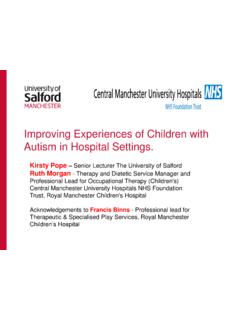Transcription of Primary Health Care and the Social Determinants of Health ...
1 Primary Health Care and the Social Determinants of Health : Synergies for equity in Health Competences for Poverty Reduction (COPORE) Project Conference Hogeschool van Amsterdam 23-24 April 2010. Dr. R diger Krech, Director Anand Sivasankara Kurup, Technical Officer Department of Ethics, equity , Trade and Human Rights Outline Primary Health care WHO constitution What it entails: Alma-Ata declaration Renewal of Primary Health Care Social Determinants of Health Why should we address Social Determinants of Health ? Commission on Social Determinants of Health : Key recommendations Synergy between Primary Health care and Social Determinants of Health Health equity Intersectoral action Community mobilization Primary Health care WHO Constitution- 1948. Health is a state of complete physical, mental and Social wellbeing, and not merely the absence of disease or infirmity The enjoyment of the highest attainable standard of Health is one of the fundamental rights of every human being without distinction of race, religion, political belief, economic or Social condition.
2 Governments have a responsibility for the Health of their peoples which can be fulfilled only by the provision of adequate Health and Social measures. Declaration of Alma-Ata 1978. Defined Primary Health care as essential Health care based on practical, scientifically sound and socially acceptable methods and technology made universally accessible to individuals and families in the community through their full participation at a cost that the community and country can afford to maintain at every stage of their development in the spirit of self-reliance and self-determination. It forms an integral part both of the country's Health system, of which it is the central function and main focus, and of the overall Social and economic development of the community. It is the first level of contact of individuals, the family and community with the national Health system bringing Health care as close as possible to where people live and work, and constitutes the first element of a continuing Health care process.
3 Values of Alma- Ata Declaration equity Fairness and Social justice Universality Access, affordability, Health as a human right Community participation participation in the planning, organization, operation and control of Primary Health care, Solidarity community and individual self-reliance making fullest use of local, national and other available resources Intersectoral action With in Health sector Outside Health sector Renewal of Primary Health Care- 2008. The four reforms How experience has shifted the focus of PHC. Early attempts at PHC Current concerns of PHC Reforms A basic package for the rural poor Universal access, comprehensive services Mother and child focus All disadvantaged groups Acute, infectious, diseases Health risks, illness across life course Healthy local environment Healthy global and local environments Scarcity and downsizing Managing growth to universal coverage Government, top-down services Public/private mixed Health systems Bilateral aid, technical assistance Global solidarity, joint learning First level care, not hospitals Coordinated referral to appropriate care PHC is cheap PHC is not cheap, but good value for money Why renewal of PHC?
4 Significant progress but not a given: child deaths in 1975 and 2006. Why renewal of PHC? (cont'd). Significant progress but not a given: child deaths in 1975 and 2006. Why renewal of PHC? (cont'd). Significant progress but not a given: child deaths in 2006. At 1978 rates Actual What would have been feasible Social Determinants of Health Why treat people .. then send them back to the conditions that made them sick? Mortality from Tuberculosis in England and Wales Social Determinants is NOT a new finding! Global Plan: TB not eliminated by 2050. 10000. Current trend ( ). extrapolated Incidence/million/yr 1000. Global Plan prediction: 100. incidence falls 5-6%. per year 10. Desired trend Elimination target: 1 / million / year by 2050. 1. 1990 2000 2010 2020 2030 2040 2050.
5 Why is this happening? Upstream Weak and inequitable economic, Globalisation, migration, Social , and environmental policy urbanisation, demographic transition Weak Health Poverty, low SES, system, poor access low education Inappropriate Health Unhealthy seeking behaviour Downstream Active TB Crowding Tobacco HIV, malnutrition, lung Age, sex cases in Poor smoke, air diseases, diabetes, and genetic community ventilation pollution alcoholism, etc factors High level contact with Impaired host infectious droplets defence Exposure Infection Active disease Consequences Lonnroth et al. 2008. Pattern of inequity matters for intervention strategies % of children receiving six or more child-survival interventions 100%. 80%. Children (%). 60%. 40%. 20%. 0%. Poorest 2nd 3rd 4th Least poor S ocio-economic group Brazil Benin Cambodia Life expectancy at birth (men).
6 Glasgow, Scotland (deprived suburb) 54. India 61. Philippines 65. Korea 65. Lithuania 66. Poland 71. Mexico 72. Cuba 75. US 75. UK 76. Glasgow, Scotland (affluent suburb) 82. Source: WHO World Health Report 2006; Hanlon P,Walsh D & Whyte B, 2006. Prevalence of daily tobacco smoking Q1. Q3. Q2 Q1. Q2. %. Q3. Q4. Q1 Q2. Q4. Q3 Q4 Q5. Q5 Q5. Low income Low er-middle income Upper-middle income % of poorest smoking tobacco is almost double as that of the % of richest smoking tobacco daily in in low income countries, where as this difference in upper middle income countries is very low. What are the Social Determinants of Health ? The poor Health of the poor, the Social gradient in Health within countries, and the marked Health inequities between countries are caused by: Structural Determinants : the unequal distribution of power, income, goods, and services, globally and nationally, Conditions of daily life: the consequent unfairness in the immediate, visible circumstances of peoples lives their access to Health care, schools, and education, their conditions of work and leisure, their homes, communities, towns, or cities and their chances of leading a flourishing life.
7 Together, the structural Determinants and conditions of daily life constitute the Social Determinants of Health . Source: Commission on Social Determinants of Health (2008). Social Determinants of Health conceptual framework Commission on Social Determinants of Health , 2008. Common Social Determinants of Health Level NTD TB HIV Injuries Socio-economic status, Socio-economic status, Socio-economic Socio-economic status, Socio-economic gender, ethnicity gender, ethnicity status, Gender ethnicity context Social norms, cultural Social norms, cultural Social norms, cultural Social norms, cultural Differential beliefs and practices, beliefs and practices, beliefs and practices, beliefs and practices, Exposure living conditions, poor living conditions, lifestyle, conflicts living conditions, nutrition, crowding, crowding, conflicts crowding, conflicts conflicts & natural disasters Poverty, low access to Poverty, low access to Poverty, low access to Gender, early Differential Health care Health care Health care, gender, childhood experiences.
8 Vulnerability early childhood abuse experiences, abuse Inadequate Health Inadequate Health Inadequate Health Inadequate Health Differential Health services, use of services, use of services, use of services, use of outcomes treatment and care treatment and care treatment and care treatment and care Social and financial, Social and financial, Social and financial, Social and financial Differential stigma, exclusion stigma, exclusion stigma, exclusion consequences Why emphasise Social Determinants ? Social Determinants of Health have a direct impact on Health Social Determinants predict the greatest proportion of Health status variance Social Determinants of Health structure Health behaviours Social Determinants of Health interact with each other to produce Health Overarching Recommendations 1.
9 Improve Daily Living Conditions 2. Tackle the Inequitable Distribution of Power, Money, and Resources 3. Measure and Understand the Problem and Assess the Impact of Action. Action on the Social Determinants of Health and Primary Health Care Much common ground Both advance holistic view of Health , with Primary value of Health equity The Declaration of Alma implicitly referred to the Social Determinants Different relationship to Health systems and broader context Primary Health care starts with the Health sector and reaches out to other sectors Social Determinants discourse sees Health sector as one of the Social Determinants Synergistic Report of the Commission and the WHR on Primary Health Care thus complement each other Synergies between Primary Health care and Social Determinants of Health Health equity Broad view of Health Universally applicable Key role for Health sector Health in all policies Multisectoral action Role of communities and Social environment DIFFERENCE Perspective/ Lens What can we do about it?
10 As planners and policy makers understand and actively promote in our policies and plans that : Health is created mostly outside the Health sector to reduce inequities, addressing Social Determinants is essential, and multisectoral action is the only way forward achieving Health equity contributes to Social and economic development of the society, and ensures Social justice involvement of communities is a must for achieving the desired goals of Health equity As researchers: Actively undertake and promote research that explore the underlying Social Determinants of Health issues, and contribute to the knowledge base disseminate good practices of addressing Social Determinants of Health and Primary Health car







